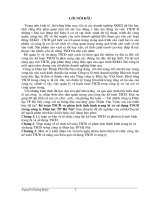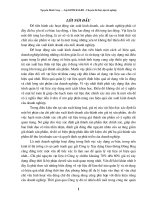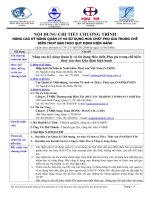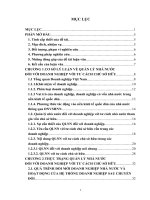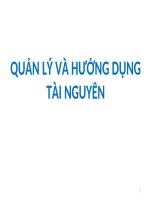QUẢN LÝ VÀ HƯỞNG DỤNG TÀI NGUYÊN - Natural Resource Management,Chapter II quyen so huu va huong dung tai nguyen
Bạn đang xem bản rút gọn của tài liệu. Xem và tải ngay bản đầy đủ của tài liệu tại đây (228.46 KB, 49 trang )
Chapter II
Sở hữu và hưởng dụng tài nguyên
thiên nhiên
- Property Rights, Property Rights
Regimes and Resource tenure
1
What are Property Rights?
• The entitlements defining owners' rights and
duties in the use of the resource.
• Domains where peoples social relations
concerning access to, use and control over
´things’ are defined.
• Property rights define permitted, prohibited, and
required uses.
2
Elements of Property Rights
1. Access: the right to enter a defined physical
property.
2. Withdrawal: the right to withdraw the product
of the property. For example: harvest fuelwood, catch fish, use water, etc.
3. Management: the right to regulate internal use
and make improvements in the resource.
3
Elements of …
4. Exclusion: the right to determine who will have
an access right, and how that right may be
transferred to others.
5. Alienation: the right to sell or lease the
collective choice rights of management and/or
exclusion.
4
• Access, and withdrawal are operational level
property rights.
• Management, exclusion, and alienation are
collective-choice level property rights.
5
Categories of Position in Property Rights
1. Authorized users
2. Claimants
3. Proprietors
4. Owners
6
Authorized Users
Individuals holding rights of access and
withdrawal.
These rights may be transferred to others either
temporarily or permanently.
Their rights are defined by others who hold
collective-choice rights of management and
exclusion.
They cannot devise their own harvesting rules.
7
Claimants
Individuals who possess operational rights plus
the collective-choice rights of management.
They cannot specify who may not have access
to resources nor can they alienate their right of
management.
8
Proprietors
Individuals who possess collective-choice
rights to participate in management and
exclusion.
9
Owners
Individuals who can sell or lease their collectivechoice rights (i.e. rights of management and/or
exclusion).
10
Hưởng dụng tài nguyên
• Natural resource tenure is broadly defined as the
arrangements through which people gain legitimate
access to natural resources; the conditions under which
they use those resources and participate in the benefits
deriving from them; and the institutions and processes
for the management of those resources.
• Tenure is broader than ownership. It refers to a bundle of
both rights and obligations – rights when it comes to
owning, holding, using, managing or transferring
resources, and obligations when it comes to using
resources in such a way so as to not harm others, and
paying taxes, fees and other duties. These rights and
obligations are defined by national law, customary rules,
or a combination of the two.
11
Hưởng dụng tài nguyên
• Natural resource tenure is broader than land tenure. Distinct
tenure arrangements apply to agricultural and urban land,
rangelands, water, wetlands, coastal areas, forests, biodiversity,
petroleum and mineral resources. Rights to different resources
pertaining to a piece of land may be held by multiple users, and at
different times of the year. A forest, for instance, may provide
resources as diverse as timber, firewood, fodder, medicinal plants
and food. It may even serve as a source of enjoyment or
recreation. Rights to these resources may be vested with different
people.
• In addition, rights to a resource – for example, a mining
concession – may conflict with other resource rights or uses,
such as the land rights of local farmers. Increasing global
demands, such as for biofuels, may enhance the competition for
different land uses. This multiplicity of resources, resource rights,
uses and users raises challenges for tenure policies and
programmes.
12
Các hình thức hưởng dụng tài nguyên
13
De Jure & De Facto Property Rights
• De Jure rights: formal rights. The rights
recognized by Law.
• De Facto rights: informal rights (e.g. customary
rights).
Note: De Jure and De Facto rights may overlap,
complement, or conflict with one another.
14
Property Rights, Incentives, and Outcomes
• Property rights affect the incentives individuals
face.
– The rights of exclusion: produces strong
incentives for investment (at least shortterm) on the resource because it allows
the right-holder to decide who can and
who cannot enter the resource.
15
Property Rights, Incentives …
• The rights of alienation: (i) can affect long-term
investment on the resource, (ii) permits the
right-holder to put the resource to a more
productive use.
Note: right of alienation, however, does not
guarantee the survival of a resource.
16
Property Rights, Incentives …
• The level of incentives can also be affected by
the context.
Example: for physically isolated settlements, the
right of exclusion may not be so important.
17
Property Rights Regimes Applicable to
Natural Resources
1. Private property
2. Common property
3. Public (or state) property
4. Open access
18
Private Property
• Ownership: Owned by an individual or group of
individuals.
• Rights and duties:
– Individuals have the right to undertake
socially acceptable uses, and have duty to
refrain from socially unacceptable uses.
– Others (called "non-owners") have duty to
refrain from preventing socially acceptable
uses, and have a right to expect that only
socially acceptable uses will occur.
19
Common Property
Ownership: Co-owners; use rights for the
resource are controlled by an identifiable group
of local people.
• Rights and duties:
The management group (the "owners") has
right to exclude non-members, and nonmembers have duty to abide by exclusion.
Individual members of the management
group (the "co-owners") have both rights and
duties with respect to use rates and
maintenance of the resource owned.
20
• Common property regimes were once
widespread around the globe. Overtime
many of them disappeared. Reasons could
be:
– Effect of technological and economic
change
– Legislated out of existence by the state
• Informal: simply wiped out when the
governments for the first time formalized and
codified PRs to the resources.
• Formal: transformed to individuals as private
property.
21
Public Property
• Ownership and management control is held by
the government.
• Rights and duties:
Agencies have right to determine use/access
rules.
Individuals have duty to observe use/access
rules determined by controlling/managing
agency.
22
Open Access
• Ownership: Owned by nobody; free for all.
• Rights and duties:
No defined group of users or "owners" and
benefit is available to anyone.
Individuals have both privilege and no right
with respect to use rates and maintenance of
the resource.
23
Which Type of PR Regime is
Appropriate for NRM?
• No single type of property rights regime can be
prescribed as a remedy for all problems of
resource degradation and overuse.
• Effectiveness of a property rights regime
depends upon the context (i.e. environmental,
economic, social, and political conditions).
24
• Open access works well only when there is no
or little need to manage a resource at all (when
the demand is too low and the resource is
available in plenty). In such cases, the
management efforts will not be worthwhile.
25

